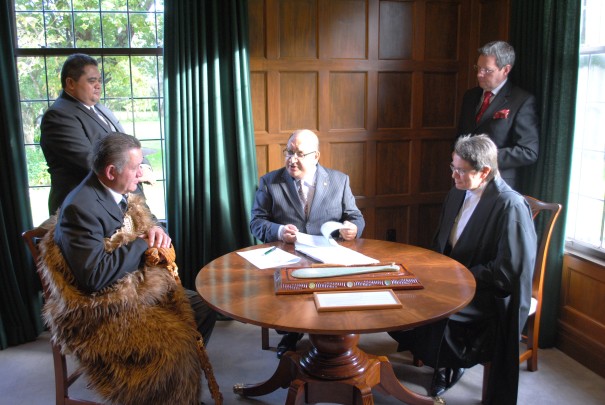Royal Assent given to Waikato River legislation

Tihe mauriora. Arikinui Kingi Tuheitia, Me koe Atawhai, Me tō rōpū.
Tomo mai, nau mai, Ki tēnei kāinga, a Vogel Whare.
Ka tuku aroha ki a tātou mate, Otirā, ki a Kahurangi Raiha Mahuta.
Arikinui, Whakapiri mai ki te taonga a Tainui Te patu pounamu o te Raupatu, Kei konei e takoto ana.
Haere mai ki te whakapono, taku tuhinga i te mana o Te Kuini o Aotearoa, Ki runga i tēnei ture, Mō te Awa o Waikato.
No reira, Kia ora huihui tātou katoa.
The Governor-General gives Royal Assent to the Bill.
I then greet everyone in all the languages of the realm of New Zealand, in English, Māori, Cook Island Māori, Niuean, Tokelauan and New Zealand Sign Language. Greetings, Kia Ora, Kia Orana, Fakalofa Lahi Atu, Taloha Ni and as it is the morning (Sign)
I then specifically greet you: Arikinui King Tuheitia and Te Atawhai; Tukoroirangi Morgan, Chair of Te Arataura; Mary Harris, Clerk of the House of Representatives; Distinguished Guests otherwise; Ladies and Gentlemen.
Thank you for joining my wife Susan and I for this ceremony to mark Royal assent being given to the Waikato-Tainui Raupatu Claims (Waikato River) Settlement Bill.
Fifteen years ago on 3 November 1995, Her Majesty Queen Elizabeth II, Queen of New Zealand, gave Royal assent to the Waikato Raupatu Claims Settlement Act 1995.
That ceremony, at Government House in Wellington, was attended by many dignitaries, and most notably, the late Te Arikinui Dame Te Atairangikaahu.
The ceremony followed the signing of a Deed of Settlement at Turangawaewae Marae on 22 May 1995 by the then Prime Minister, the Rt Hon Jim Bolger and Dame Te Ata.
The Act included an apology from the Crown for the wrongs it had committed and significant redress.
When the Deed of Settlement was signed, Waikato-Tainui gifted to the Crown a beautiful pounamu mere, Te Raupatu. That mere was on display in Government House in Wellington prior to its closure and is on display here at Government House Vogel, and is with us in this room for this occasion.
However, both the Deed and the Act expressly set to one side certain claims from the settlement including the claims of Waikato-Tainui in relation to the Waikato River that arose as a result of the Raupatu of the 1860s and its consequences.
The Crown’s 1863 invasion by both land and the Waikato River was a double blow to Waikato-Tainui. Since that time Waikato-Tainui have watched with distress the deterioration in the River while under the authority of the Crown.
Negotiations with the Crown were commenced by the late Sir Robert Te Kotahi Māhuta on behalf of Waikato-Tainui in 1999.
Following his death, negotiations started again in 2005 led by the late Lady Raihā Māhuta and Mr Morgan, leading to the Deed of Settlement and the Kiingitanga Accord between the Crown and Waikato-Tainui signed on 22 August 2008. A review saw a revised Deed signed on 17 December last year.
This legislation achieves several ends. In a practical sense, it gives legislative effect to the revised Deed. New bodies will created, tasked with the practical process of cleaning up the Waikato River.
It also acknowledges the past, of the longstanding claims by Waikato-Tainui that result from the raupatu of the 1860s and the Crown’s breaches of the Treaty of Waitangi.
It also acknowledges the present, of Waikato-Tainui’s ongoing relationship with the River and its ongoing deterioration.
But most importantly, it acknowledges a future vision and strategy for the River. As the Act says at the outset: “The overarching purpose of the settlement is to restore and protect the health and wellbeing of the Waikato River for future generations.”
That is a mighty purpose. The road to this ceremony has been long, and at times difficult. I commend everyone, including those no longer with us, for their commitment to that purpose.
Today then is about celebration and recognising a great achievement. Tomorrow begins the even harder work of turning words into deeds. The task ahead will be equally difficult and complex. But imbued with the best of intentions of the settlement and the Treaty, I look forward to your ongoing work.
Viewing the Waikato River today, New Zealand’s longest river, it is hard to imagine what it once looked like. More than 150 years ago, the Austrian geologist Ferdinand von Hochstetter travelled throughout New Zealand and was immediately struck by its beauty. He wrote in 1859: “The impression made by the sight of the majestic stream is truly grand. It is only with the Danube or the Rhine, that I can compare the mighty river, which we had just entered.”
And on that uplifting note I will close in Māori, by offering everyone greetings and wishing you all good health and fortitude in your endeavours. No reira, tēnā koutou, tēnā koutou, kia ora, kia kaha, tēnā koutou katoa.
To view images from the ceremony, click here
